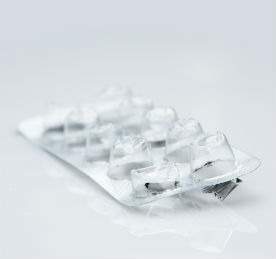
While packaging often seems like little more than a hindrance to enjoying a product, it does serve a very practical purpose. A huge amount of thought goes into those bits of cardboard and plastic that keep our new purchases pristine, and the science beyond it all is changing fast.
One essential function it provides is safety; products must be protected in transit and throughout their subsequent life-cycles. Another is security: tampering, contamination, theft and loss must also be guarded against.
The most commonly used materials in packaging overall are plastic and cardboard, while in the pharmaceutical industry, plastic and aluminium are normally the best choices for keeping time-sensitive or organic products fresh, and the blister method is an increasingly attractive option.
Easy as PVC
The term ‘blister’ encompasses several types of pre-formed plastic packaging used for small consumer goods, foods and pharmaceuticals.
The primary component of a blister pack is a cavity, or pocket, frequently made from inexpensive and easily-thermoformed polyvinyl chloride (PVC). This usually has a backing of paperboard or a lidding seal of aluminium foil or plastic. Such packs are useful for protecting products against external factors, such as humidity and contamination for extended periods of time. Opaque blisters also protect light-sensitive products against UV rays.
Blister packaging is often used to hold individual capsules within a larger carton; the packaging protects the contents from contamination. Depending on the nature of the film material used, blister packs can feature either a peelable layer or push-through lidding as a way to remove the contents of a package.
Perhaps the most notable application of blister technology is for tablets such as aspirin, where the pop-out plastic capsule form has become ubiquitous.
They are easy to use and reliably safe, and can also be used for medical devices, though the materials must be harder-wearing and less likely to break or be damaged.
Medical blister trays also differ from pharmaceutical blister packs in that they are not push-through packs. The thermoformed base web used in them is made of a thicker sheet – generally 500–1,000µm – and cannot be collapsed, thus forming a solid tray.
The lidding film also provides a peel-open feature and is generally made from a porous material (such as Dupont’s Tyvek) to enable sterilisation.
These packs are used for sterile medical devices used in hospitals, and are more expensive to make than their pill-carrying counterparts and, having been peeled, may only be used once.
A thicker plastic sheet makes for a more solid package that is resistant to pressure, since these devices must be handled with extra care. Medical-device-style trays are sealed by knurling or heat, using pre-cut pieces of the lidding material. Codes can be embossed on the lid for traceability.
Clamshell blister packs, meanwhile, are currently the preferred choice where the integrity of a device is paramount. These consist of two combined plastic sheets, or a single sheet that folds over itself. The result is a package that resists in-store tampering, as it must be opened at home with scissors.
This form of packaging, which tends to have smaller, tightly defined compartments, is also able to immobilise products, which reduces the risk of damage during transit. Other perceived benefits of the clamshell pack include visibility (blister plastic is usually transparent); customisation (blisters are thermoformed to products’ specific shapes, guaranteeing a snug fit, regardless of quantity or size); and the choice of packaging material (manufacturers can choose from a wide range of options in order to create something visually and texturally appealing).
The right price
Blister packages are simple and relatively cheap to produce, which is a significant advantage where large and bulky – as well as small and fiddly – components are concerned.
It is possible to produce a wide variety of packs simultaneously with only minor alterations to specifications, rather than having to initiate a whole new packaging process for every product, which can create huge time delays and increase costs.
Packs may also be produced that are able to contain a wide variety of items, which spares manufactuers from having to make multiple packs for small items such as pills and batteries.
With the right tools, blister packaging can be customised to suit clients’ individual needs; the largest blister pack currently possible is about the size of a suitcase.
Blister packaging’s cost-effectiveness makes it a good choice for large-scale manufacturers. This, combined with the security, integrity and product longevity it offers, makes the technology an attractive investment for medical companies looking to maximise efficiency while minimising expenditure.
Thermo-revolution
Thermoforming is a fabrication process that involves heating a sheet of plastic – or ‘film’ when referring to thinner gauges and certain material types – in an oven in order to form it over a mould to make a specific shape, and then trimming to create a usable product.
The two basic types of the processes are vacuum forming and pressure forming, and there are also derived techniques, such as twin-sheet thermoforming.
Thermoformed plastics are suitable for automotive, consumer, packaging, retail and display, sports and leisure, electronics and industrial applications.
Its advantages, which include low tooling and engineering costs, and fast turnaround times, make it perfect for prototype development and low-volume production. It is also extremely adaptable to customers’ design needs, and capable of creating incredibly light products. Materials that can be thermoformed include polystyrene, polypropylene and PVC.
Source: The British Plastics Federation






